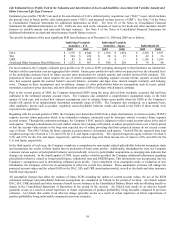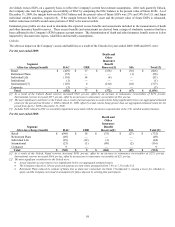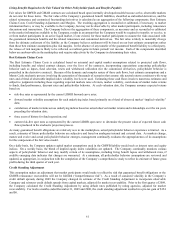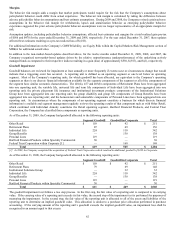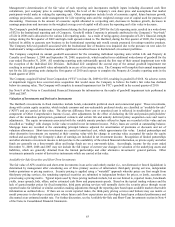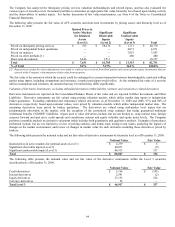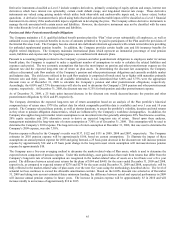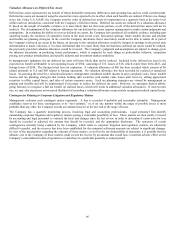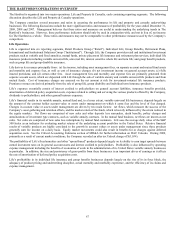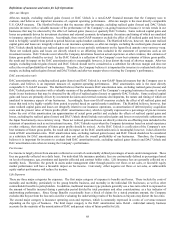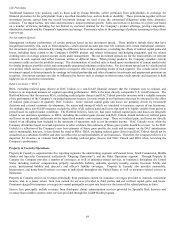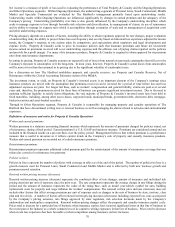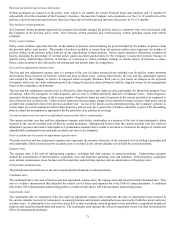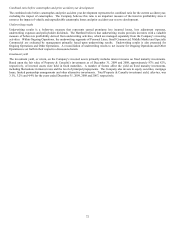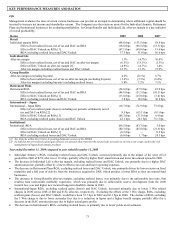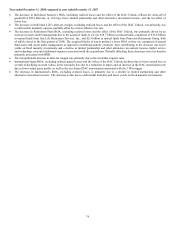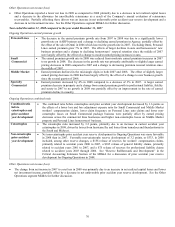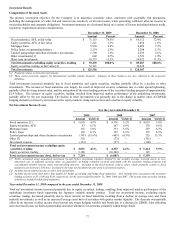The Hartford 2009 Annual Report Download - page 68
Download and view the complete annual report
Please find page 68 of the 2009 The Hartford annual report below. You can navigate through the pages in the report by either clicking on the pages listed below, or by using the keyword search tool below to find specific information within the annual report. 68
Definitions of measures and ratios for Life Operations
After-tax Margin
After-tax margin, excluding realized gains (losses) or DAC Unlock is a non-GAAP financial measure that the Company uses to
evaluate, and believes are important measures of, segment operating performance. After-tax margin is the most directly comparable
U.S. GAAP measure. The Hartford believes that the measure after-tax margin, excluding realized gains (losses) and DAC Unlock
provides investors with a valuable measure of the performance of the Company’ s on-going businesses because it reveals trends in our
businesses that may be obscured by the effect of realized gains (losses) or quarterly DAC Unlocks. Some realized capital gains and
losses are primarily driven by investment decisions and external economic developments, the nature and timing of which are unrelated
to insurance aspects of our businesses. Accordingly, these non-GAAP measures exclude the effect of all realized gains and losses that
tend to be highly variable from period to period based on capital market conditions. The Hartford believes, however, that some realized
capital gains and losses are integrally related to our insurance operations, so after-tax margin, excluding the realized gains (losses) and
DAC Unlock should include net realized gains and losses on net periodic settlements on the Japan fixed annuity cross-currency swap.
These net realized gains and losses are directly related to an offsetting item included in the statement of operations such as net
investment income. DAC Unlocks occur when the Company determines based on actual experience or other evidence, that estimates of
future gross profits should be revised. As the DAC Unlock is a reflection of the Company’ s new best estimates of future gross profits,
the result and its impact on the DAC amortization ratio is meaningful; however, it does distort the trend of after-tax margin. After-tax
margin, excluding realized gains (losses) and DAC Unlock should not be considered as a substitute for after-tax margin and does not
reflect the overall profitability of our businesses. Therefore, the Company believes it is important for investors to evaluate both after-tax
margin, excluding realized gains (losses) and DAC Unlock and after-tax margin when reviewing the Company’ s performance.
DAC amortization ratio
DAC amortization ratio, excluding realized gains (losses) and DAC Unlock is a non-GAAP financial measure that the Company uses to
evaluate, and believes is an important measure of, segment operating performance. DAC amortization ratio is the most directly
comparable U.S. GAAP measure. The Hartford believes that the measure DAC amortization ratio, excluding realized gains (losses) and
DAC Unlock provides investors with a valuable measure of the performance of the Company’ s on-going businesses because it reveals
trends in our businesses that may be obscured by the effect of realized gains (losses) or quarterly DAC Unlocks. Some realized capital
gains and losses are primarily driven by investment decisions and external economic developments, the nature and timing of which are
unrelated to insurance aspects of our businesses. Accordingly, these non-GAAP measures exclude the effect of all realized gains and
losses that tend to be highly variable from period to period based on capital market conditions. The Hartford believes, however, that
some realized capital gains and losses are integrally related to our insurance operations, so amortization of deferred policy acquisition
costs and the present value of future profits (DAC amortization ratio), which is typically expressed as a percentage of pre-tax income
before the cost of this amortization (an approximation of actual gross profits) and excludes the effects of realized capital gains and
losses, excluding the realized gains (losses) and DAC Unlock should include net realized gains and losses on net periodic settlements on
the Japan fixed annuity cross-currency swap. These net realized gains and losses are directly related to an offsetting item included in the
statement of operations such as net investment income. DAC Unlocks occur when the Company determines based on actual experience
or other evidence, that estimates of future gross profits should be revised. As the DAC Unlock is a reflection of the Company’ s new
best estimates of future gross profits, the result and its impact on the DAC amortization ratio is meaningful; however, it does distort the
trend of DAC amortization ratio. DAC amortization ratio, excluding realized gains (losses) and DAC Unlock should not be considered
as a substitute for DAC amortization ratio and does not reflect the overall profitability of our businesses. Therefore, the Company
believes it is important for investors to evaluate both DAC amortization ratio, excluding realized gains (losses) and DAC Unlock and
DAC amortization ratio when reviewing the Company’ s performance.
Fee Income
Fee income is largely driven from amounts collected as a result of contractually defined percentages of assets under management. These
fees are generally collected on a daily basis. For individual life insurance products, fees are contractually defined as percentages based
on levels of insurance, age, premiums and deposits collected and contract holder value. Life insurance fees are generally collected on a
monthly basis. Therefore, the growth in assets under management either through positive net flows or net sales, or favorable equity
market performance will have a favorable impact on fee income. Conversely, either negative net flows or net sales, or unfavorable
equity market performance will reduce fee income.
Life Expenses
There are three major categories for expenses. The first major category of expenses is benefits and losses. These include the costs of
mortality and morbidity, particularly in the group benefits business, and mortality in the individual life businesses, as well as other
contractholder benefits to policyholders. In addition, traditional insurance type products generally use a loss ratio which is expressed as
the amount of benefits incurred during a particular period divided by total premiums and other considerations, as a key indicator of
underwriting performance. Since Group Benefits occasionally buys a block of claims for a stated premium amount, the Company
excludes this buyout from the loss ratio used for evaluating the underwriting results of the business as buyouts may distort the loss ratio.
The second major category is insurance operating costs and expenses, which is commonly expressed in a ratio of a revenue measure
depending on the type of business. The third major category is the DAC amortization ratio. Retail - individual annuity business
accounts for the majority of the amortization of DAC and present value of future profits for Life.


